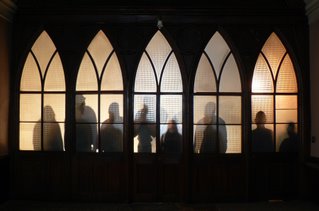The historic Prospect Park, which anchors the western edge of our study area, was featured in today's Albany Times Union and is currently the subject of an oral history project and exhibition being organized by the Rensselaer County Historical Society and the Friends of Prospect Park. The historic Poestenkill Gorge is another of the neighborhood's significant but underutilized natural, recreational, and industrial archeology resources.
From Times Union


TROY -- Prospect Park was a model recreational area when it opened a century ago, quickly becoming an attraction for city residents.
From its swimming pool to the park king and queen crowned each year, Prospect Park was part of the city's life.
The Rensselaer County Historical Society is collecting artifacts to help tell the story of the park's 100 years. They'll be part of the Prospect Park 100th anniversary exhibit that will open in May at the historical society at 57 Second St.
The society and the Friends of Prospect Park are hoping to tap the community's memory of the park to help put on the exhibit.
"I'm hoping that someone will come in and say, 'I was king or queen of Prospect Park,' " said Kathy Sheehan, the historical society registrar and curator the centennial exhibit.
The 80-acre park was designed by Garnet Baltimore, the first black to earn a bachelor's degree from Rensselaer Polytechnic Institute. The city bought the land for $110,000 from the Warren estate.
Prospect Park developed during an era of reform movements in the late 19th and early 20th centuries, Robert Engel, the historical society's executive director said. Prospect Park was part of the playground movement of that era to provide recreation opportunities in cities, Sheehan said.
The park was designed with its recreation areas an important aspect of the park, Sheehan said. The park wasn't a place to just come and visit.
"Troy was still a smokestack city," Engel said. The park provided opportunities over the decades for residents for recreation, whether it was playing tennis, playground equipment, swimming or arts and crafts. When the city's industrial base declined, so did the park.
"The park went through some hard times. People were afraid to go up there. It's not that way any more," Sheehan said.
While the park is celebrating its centennial this year, the citizens' organization Friends of Prospect Park, which advocates for the park and works to improve it, is marking its 10th anniversary.
"The park has had a great history for the city," said Peter Grimm, president of the Friends of Prospect Park and a Rensselaer County legislator.
"Ten years ago, the Friends was founded. The park had been neglected for a long time. We've turned around the whole perception of the park," Grimm said.
Increasing the awareness of the park by sponsoring various programs in the park this year is a goal, Grimm said. Part of putting on the exhibit is gathering artifacts related to the park's history.
"The best stuff is in people's attics or shoe boxes," Engel said.
"People don't like to throw stuff away," Sheehan said about the society's hopes that residents will recall a Prospect Park object and donate or lend it.
People interested in sharing artifacts with the historical society society should contact Sheehan at ksheehan@rchsonline.org or call her at 272-7232, Ext. 15.
Kenneth C. Crowe II can be reached at 454-5084 or by e-mail at kcrowe@timesunion.com.


